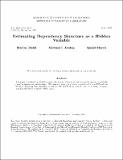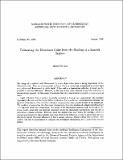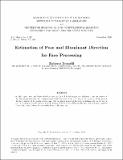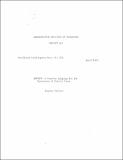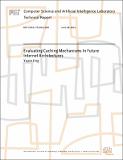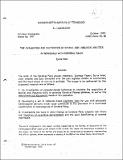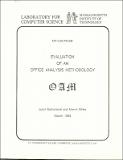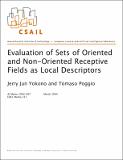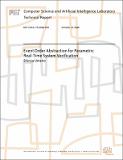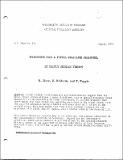Browsing Computer Science and Artificial Intelligence Lab (CSAIL) by Title
Now showing items 1125-1144 of 3804
-
Estimating Dependency Structure as a Hidden Variable
(1998-09-01)This paper introduces a probability model, the mixture of trees that can account for sparse, dynamically changing dependence relationships. We present a family of efficient algorithms that use EM and the Minimum Spanning ... -
Estimating Dependency Structure as a Hidden Variable
(1997-06-01)This paper introduces a probability model, the mixture of trees that can account for sparse, dynamically changing dependence relationships. We present a family of efficient algorithms that use EMand the Minimum Spanning ... -
Estimating Stereo Disparities
(1967-02-01)An interesting practical and theoretical problem is putting bounds on how much computation one needs to find the stereo-disparity between two narrow-angle stereo scenes. By narrow angle I mean situations wherein the angle ... -
Estimating the Illuminant Color from the Shading of a Smooth Surface
(1988-08-01)\0\05{\0\0\0\0\0\0\0\0 a uniform wall illuminated by a spot light often gives a strong impression of the illuminant color. How can it be possible to know if it is a white wall illuminated by yellow light or a yellow ... -
Estimation of Discontinuous Displacement Vector Fields with the Minimum Description Length Criterion
(1990-10-01)A new noniterative approach to determine displacement vector fields with discontinuities is described. In order to overcome the limitations of current methods, the problem is regarded as a general modelling problem. ... -
Estimation of Inertial Parameters of Rigid Body Links of Manipulators
(1986-02-01)A method of estimating the mass, the location of center of mass, and the moments of inertia of each rigid body link of a robot during general manipulator movement is presented. The algorithm is derived from the ... -
Estimation of Pose and Illuminant Direction for Face Processing
(1994-11-01)In this paper three problems related to the analysis of facial images are addressed: the illuminant direction, the compensation of illumination effects and, finally, the recovery of the pose of the face, restricted to ... -
Etna: a Fault-tolerant Algorithm for Atomic Mutable DHT Data
(2005-06-15)This paper presents Etna, an algorithm for atomic reads and writes of replicated data stored in a distributed hash table. Etna correctly handles dynamically changing sets of replica hosts, and is optimized for reads, writes, ... -
EUTERPE A Computer Language for the Expression of Musical Ideas
(1967-04-01)The electronic medium has vastly increased the amount of material available to the contemporary composer. The various pieces of electronic equipment available today allow one to produce any conceivable sound; yet ... -
EUTERPE-LISP: A LISP System with Music Output
(1967-09-01)EUTERPE (Ai memo no. 129) was designed as a "real-time music program" which would interpret music described as "voice-programs" in DDT. These voice-programs consisted of note words, description of tones to be sounded, and ... -
Evaluating Caching Mechanisms In Future Internet Architectures
(2016-06-28)This thesis seeks to test and evaluate the effects of in-network storage in novel proposed Internet architectures in terms of their performance. In a world where more and more people are mobile and connected to the Internet, ... -
The Evaluation and Cultivation of Spatial and Linguistic Abilities in Individuals with Cerebral Palsy
(1979-10-01)The work of the Cerebral Palsy project (members: Seymour Papert, Sylvia Weir, Jose Valente and Gary Drescher) over the past eighteen months is summarized, and the next phase of activity is outlined. The issues to be ... -
Evaluation of an Office Analysis Methodology
(1983-03)We have developed a model of the office that describes semi-structured office work. This model underlies an office analysis methodology and an office-specification language. An evaluation of the usefulness and practicality ... -
An Evaluation of Concurrent Priority Queue Algorithms
(1991-02)The priority queue is a fundamental data structure that is used in a large variety of parallel algorithms, such as multiprocessor scheduling and parallel best-first search of state-space graphs. -
Evaluation of Definite Integrals by Symbolic Manipulation
(1971-09)A heuristic computer program for the evaluation of real definite integrals of elementary functions is described. This program, called WANDERER (WANg's DEfinite integRal EvaluatoR), evaluates many proper and improper ... -
An Evaluation of Multiprocessor Support for Fine-grain Synchronization in Preconditioned Conjugate Gradient
(1993-02)This thesis explores the use of fine-grain synchronization in the preconditioned conjugate gradient (PCG) method using the modified incomplete Cholesky factorization of the coefficient matrix as a preconditioner. -
Evaluation of sets of oriented and non-oriented receptive fields as local descriptors
(2004-03-24)Local descriptors are increasingly used for the task of object recognition because of their perceived robustness with respect to occlusions and to global geometrical deformations. We propose a performance criterion for a ... -
Evaluation of sets of oriented and non-oriented receptive fields as local descriptors
(2004-03-24)Local descriptors are increasingly used for the task of object recognition because of their perceived robustness with respect to occlusions and to global geometrical deformations. We propose a performance criterion for a ... -
Event Order Abstraction for Parametric Real-Time System Verification
(2008-07-28)We present a new abstraction technique, event order abstraction (EOA), for parametric safety verification of real-time systems in which ``correct orderings of events'' needed for system correctness are maintained by timing ... -
Evidence for a Fifth, Smaller Channel in Early Human Vision
(1979-08-01)Recent studies in psychophysics and neurophysiology suggest that the human visual system utilizes a range of different size or spatial frequency tuned mechanisms in its processing of visual information. It has been ...


